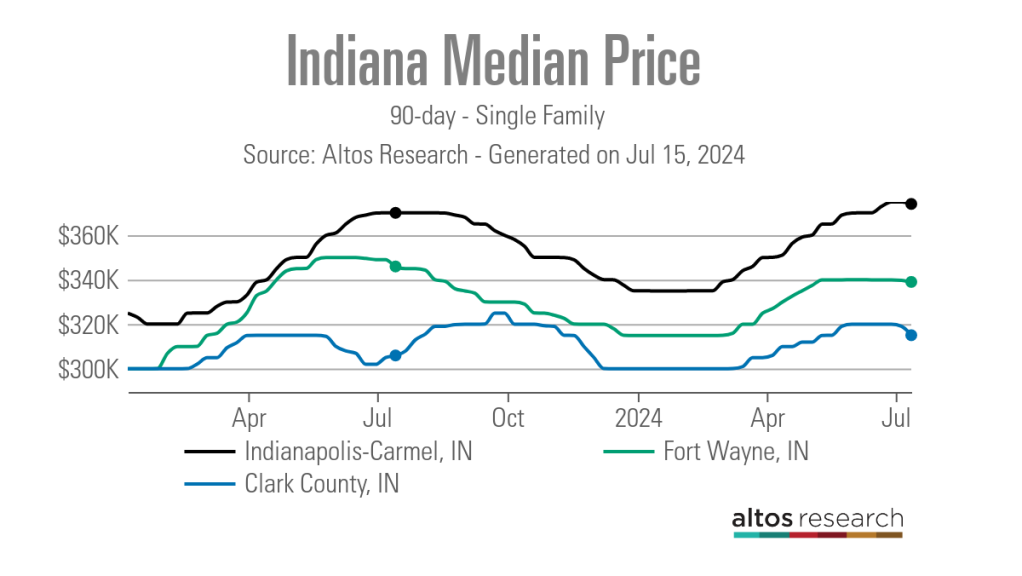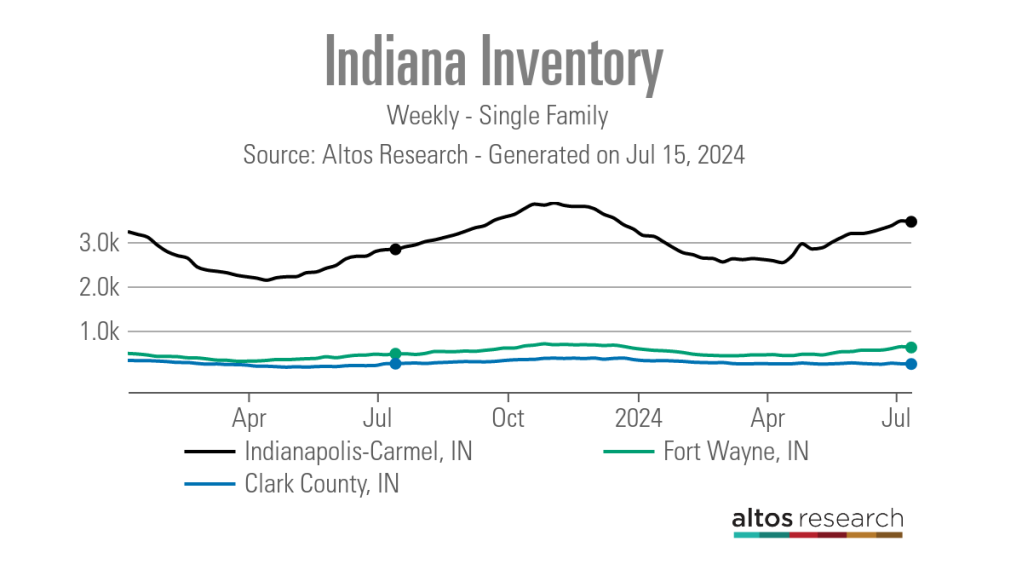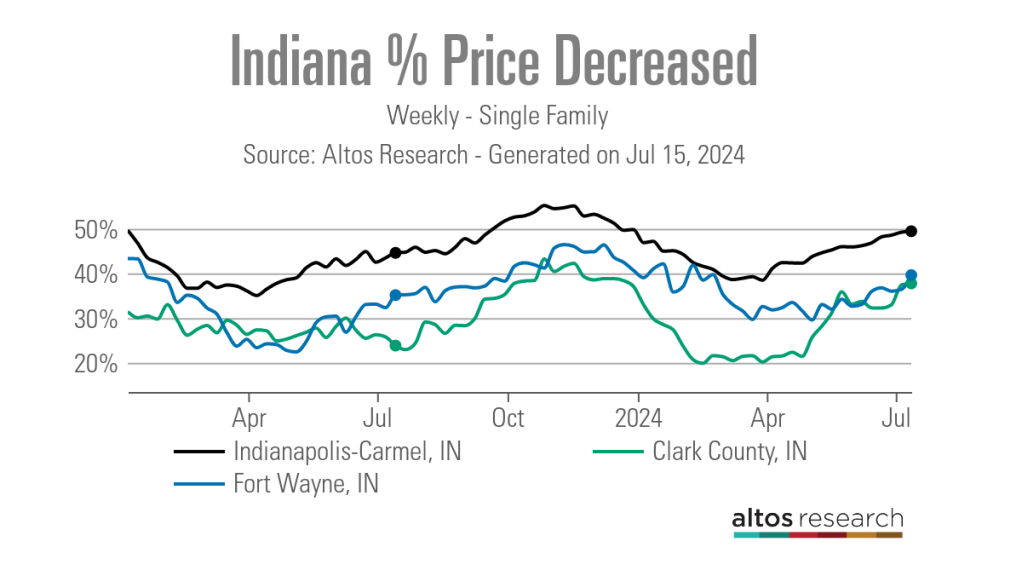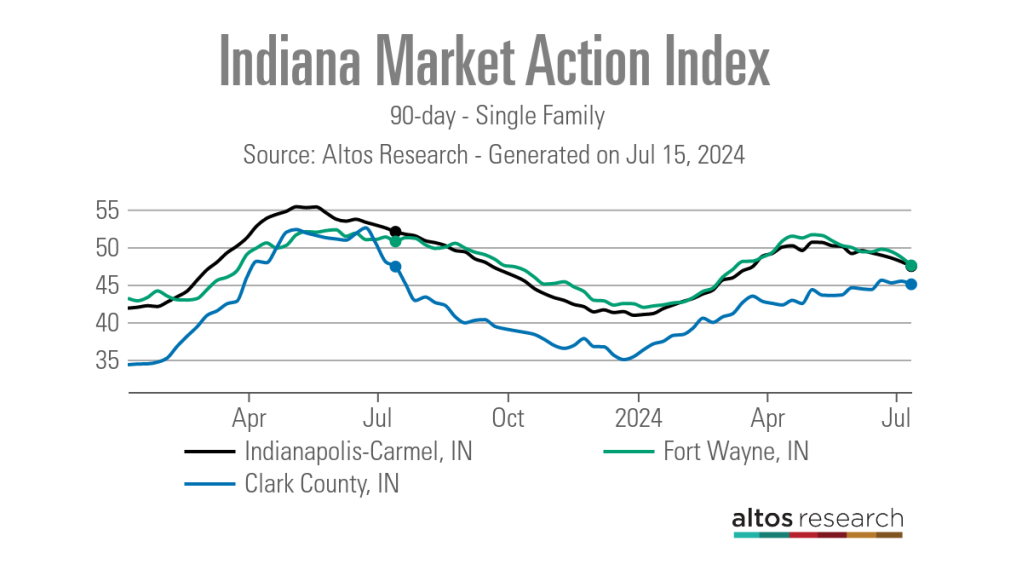Prospective buyers from out of state often come to Indiana for its growing job market, low taxes and relatively affordable housing.
Indianapolis-area Realtor Annie Caruso, a founding member of Circle Real Estate, had a buyer coming from the Chicago area for just these reasons. But their price point was under $300,000, and they were consistently outbid despite giving their best offer.
“It was tough to keep them interested in buying,” Caruso said. “It was tough to keep them motivated because of the heartbreak of losing properties.”
Four months and a slew of compromises later, the buyers got their house, but it was 50 minutes away from their place of work. Caruso said this is indicative of the markets in Indiana, where low inventory, high interest rates and inflationary pressure are still making it hard for clients to find — and afford — a home to buy.

This is reflected in home price data from Altos Research. On a 90-day rolling basis, home prices have been steadily rising in 2024 in three key Indiana markets — Indianapolis, Fort Wayne and Clark County, which is part of the Louisville metropolitan area.
The median price in Indianapolis is sitting at $374,900, a hair below its highest point since the start of the COVID-19 pandemic. The same is true for Fort Wayne ($338,950), while Clark County ($315,000) is trending slightly down from its post-pandemic peak in September 2023 ($324,900).
Indiana is benefiting from the broader housing boom in the Midwest, which has long been a region of the country with stagnant home prices, a result of the Steel Belt turning into the Rust Belt.
In the most recent new-home sales data from the U.S. Census Bureau, seasonally adjusted home sales in the Midwest were up 13.3% year over year. This stood in stark contrast to dramatic decreases in the Northeast (-43.8%), South (-17.7%) and West (-20.9%).

Markets in Indiana could see a burst of new activity because of mortgage rates. Realtors in the area say that buyers who were trying to wait out the high rate environment are choosing to accept that current rates are simply the new normal. That’s led to a rise in new listings in Indianapolis as more homeowners are putting their houses on the market.
But the Federal Reserve has indicated it expects a rate cut by the end of the year as inflation has cooled considerably and the job market has softened. This is likely to lead to a release of pent-up demand that’s been building since rates rose in 2022.
“As soon as we see a dip in these rates at a consistent level, really in the 6s and below, you’re going to see a massive influx of buyers hit the market,” said Michael Patmore, an Indianapolis-area agent with Century 21 Bradley Realty and board president for the Upstate Alliance of Realtors.
“So, now is really a good time because you don’t have as much competition,” he added. ”I’ve been telling my buyers, ‘Look, you need to buy now because if you don’t, you’re going to be back to the days of 2020 and 2021 when you’re fighting to the death to get these properties.’”

Data from Altos shows that Clark County is slightly softer than Indianapolis and Fort Wayne, with price cuts rising at a higher rate than in Indianapolis or Fort Wayne. But Louisville metro-area Realtor Bill Burns of RE/MAX FIRST said the area is growing because of new jobs in manufacturing and other industries, in addition to migration from the Kentucky side of the border.
According to a HousingWire analysis of CoreLogic data, per-square-foot home prices have risen 39.6% in the Louisville metro area since 2020, outpacing the national growth rate of 33.8%.
“We have transactions frequently where people are moving from the Louisville market to southern Indiana, either to avoid tolls or they know that their dollar goes further over here,“ Burns said. “Their car insurance is about 40% cheaper because Indiana is a no-fault state. Property taxes are about the same. It’s a little bit of a smaller city, but with the proximity to Louisville, you can enjoy the larger city.”
Taken together, Indiana isn’t too dissimilar to conditions in most of the country. High rates and massive affordability issues are leading to rising inventory and more price cuts.

This is shifting the market toward buyers. Altos’ Market Action Index shows Fort Wayne and Indianapolis drifting lower, while Clark County has stalled. Altos considers anything above 30 to be indicative of a seller’s market — and with the number for these three areas landing between 45 and 50, sellers still have the upper hand. But rate cuts are looming.
“I’m optimistic,” Caruso said. “The numbers might not necessarily show that right now, but I am optimistic that buyers are coming to the conclusion that our interest rates are going to be where they’re at. If [rates fall] half a point, we’re going to see a lot more interest, but maybe not a lot more movement. If rates drop a considerable amount, we’re going to see tons of movement.”





